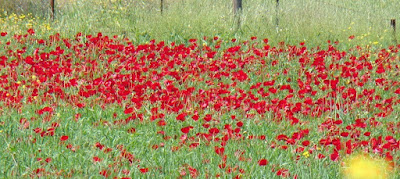-->
Five Greek poppies, three varieties
This blog began two years ago today. At the time, I had no conscious intention as to where it was going, but I would have been quite certain that I couldn't have found 121 topics to write about. I began the first in a garden, and I returned to the garden a year ago. This year it is less a garden than a war zone. I was unable to keep up with it for the most important two months of the growing season, what with Byzantine conferences in Australia and at Dumbarton Oaks, a new grandson, and two cataract operations, and now it is daily hand-to-hand combat. It is profoundly disturbing to be aware that all the time I am weeding, the weeds are growing just beyond my reach.
It is quite obvious why God put humans into his garden, when you see what happens to a garden without them, and a garden is a poor place on which to base one's theology, if you consider the preponderance of strangling plants. That must be where the idea of the snake came from, though the person who made up the story knew little about gardening or snakes, either. The best thing you can say about garden theology is that much of the real work is done on one's knees, and I am always fascinated with how respectful passers-by are of me when I am down there in the dirt communing with the weeds. And the tiny yellow-bellied spiders. And the beetles. There was a magnificent beetle this afternoon in many-sectioned silvered armor.
This spring and early summer were unusually chill and wet, superior for the strangling plants, but very poor for almost everything else, and especially too cool for sitting under the grape arbor. Most of the small cherry crop spoiled on the tree before it ripened. Nine-tenths of the iris failed to bloom at all. Several dozen large buds on the Abraham Darby roses aborted. The Pat Austin produced of two roses, neither of which could hold her head up. On the other hand, I thought the Tradescants had been ruined by black spot but they have pulled themselves back splendidly. The rugosas have been great -- especially the pale yellow that was up for eviction for non-production, and the weebly white rose that has looked like fainting for four years abruptly threw out half a dozen blooms before settling in to produce three new canes.
And the poppies! The poppies have been spectacular. Glimpsing the small patches of poppies is like hearing laughter. They have gone about their business, unaffected by the chill and the damp. There are new ones this year -- large dreamy things like girls in floaty dresses -- mixed in with the cornflowers, each in a different shade of red, pink, orange, yellow.
-->
The giant poppies, both up by the house and down at the sidewalk, have been stupendous. After several years of three or four begrudged blooms, they have erupted into dozens.
-->
We have identified three varieties of poppies resulting in the seeds brought back from Greece over the years, and here I have learned a profound lesson. I had noticed in Greece that poppies tended to grow in land that had been turned over and I have been careful to dig up their patches every fall. The poppies grew up full of tall grass and weeds, so I carefully over several days weeded between their slender stems and untangled their necks from the tall grass. Weedless, the poppies lay down on the ground and declined to stand. I carefully staked each one. Staked poppies look like prisoners in the stocks.
Then the Eureka! moment. Greek poppies often grow in grain -- which of course needs the land turned over -- or tall grass. As you can see in the picture below, the buds hang completely down (unlike the buds of the giant poppies above) and hook if they can onto whatever is nearby. Thus they have the support of the grain or grass that is also growing up. When they are ready to bloom, the heads have got up to the surface of the field, nicely propped, and then the hook straightens out for the full bloom. Poppies need their weeds. I will know this next year. As with tomatoes and children, you cannot get lovely results by insisting on your own way.
The color of the poppies changes as they age, or even as they move against the light. We have little space in the yard, really, and I cannot help comparing my small patches with the fields I saw last 16 April near Midea.
Some poppies photograph with more success than others. We also have the lemon Icelandic poppies that appear individually in odd places, such as beside the posts of the arbor:
-->
or the so-called California poppies (not really poppies) that bunch in corners like piles of tangerines.
The best picture, I think, is this that shows the extraordinary beauty, magnificent with spots like the great cats, of poppies that have been surprised by time.
-->
. . . there is yet faith
But the faith and the love and the hope are all in the waiting.
Wait without thought, for you are not ready for thought:Wait
But the faith and the love and the hope are all in the waiting.
Wait without thought, for you are not ready for thought:Wait
So the darkness shall be the light, and the stillness the dancing.
Whisper of running streams, and winter lightning.
The wild thyme unseen and the wild strawberry,
The laughter in the garden, echoed ecstasy . . .
Whisper of running streams, and winter lightning.
The wild thyme unseen and the wild strawberry,
The laughter in the garden, echoed ecstasy . . .
From T. S. Eliot, Four Quartets:East Coker









No comments:
Post a Comment
I will not publish Anonymous comments.